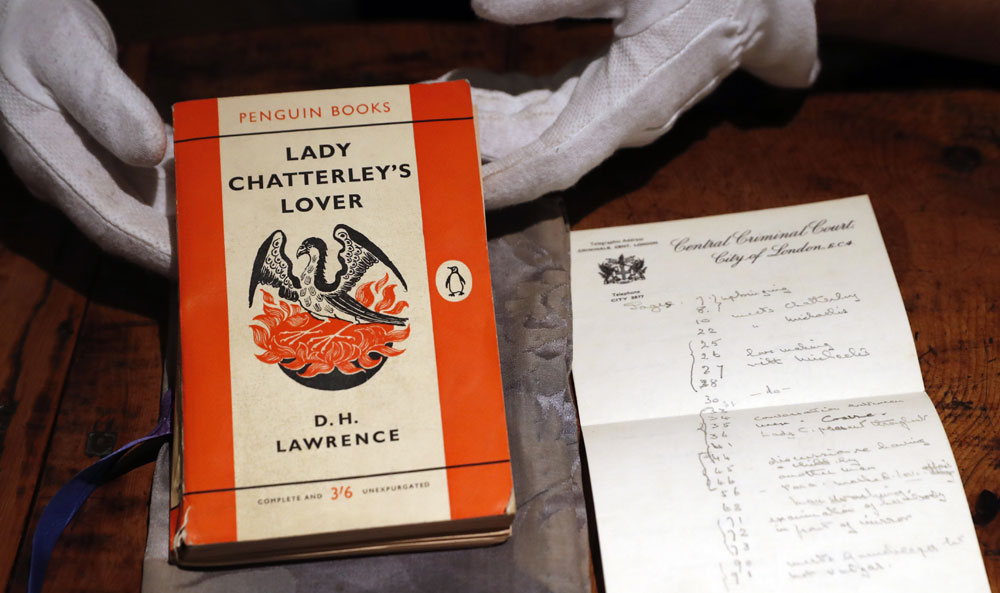D.H. Lawrence’s Lady Chatterley’s Lover is at the centre of a ban once again but this time, ironically, it is to stop a copy of the sexually explicit novel being exported out of the UK.
This is a very special copy: full of annotations, it was used by the trial judge Sir Laurence Byrne in the sensational obscenity trial of 1960 in London which changed for ever what could or couldn’t be published.
Britain’s arts minister Michael Ellis said on Monday: “The trial of Lady Chatterley’s Lover captured the public attention in 1960. It was a watershed moment in cultural history, when Victorian ideals were overtaken by a more modern attitude.
“I hope that a buyer can be found to keep this important part of our nation’s history in the UK.”
Experts on the Reviewing Committee on the Export of Works of Art and Objects of Cultural Interest (RCEWA) too recommended that the artwork be kept in the UK.
RCEWA chairman Sir Hayden Phillips said it would be a “misfortune” if the copy “left our shores”.
The novel, which details the physical relationship between an upper class woman, the former Constance Reid, Lady Chatterley, and a working class gamekeeper, Oliver Mellors, explores whether there can really be love between a man and a woman without sex.
The novel, which came out two years before Lawrence’s death in 1930, was privately published in 1928 in Italy and in 1929 in France and Australia.
But Lawrence’s description of the sex between the couple was considered so graphic that the novel could not be released in the author’s own country for 30 years. He also used four-letter words.
In fact, an unexpurgated edition was not published openly in the UK until 1960, when it was the subject of a watershed obscenity trial against the publisher, Penguin Books.
Penguin decided to publish the uncensored work to test the 1959 Obscene Publications Act, which was designed to protect works of literature while strengthening laws against pornography. It won the case and quickly sold 3 million copies.
The judge’s copy, annotated by himself and his wife Dorothy, has been sold to an overseas buyer for £56,250. There are notes, a list of page numbers and short summaries of various parts of the novel. Words like “love making” and “coarse” are jotted in the margins.
Dorothy also sewed a blue-grey fabric bag for her husband to carry the book to and from court.
The judge’s family owned the copy until it was first sold at Sotheby’s in 1993, and auctioned again in October last year.
Sir Hayden, the RCEWA chairman, said: “The prosecution of Penguin Books for publishing Lady Chatterley’s Lover was one of the most important criminal trials of the 20th century.
“Judge Byrne’s copy of the novel, annotated by him and his wife, may be the last surviving contemporary ‘witness’ who took part in the proceedings.
“Picture the scene: the High Court Judge presiding in his red robes, his wife beside him on the Bench — as was allowed in those days — as a succession of singular and distinguished witnesses for the Defence were cross examined day by day.
“I was 17 at the time and studying DH Lawrence as a set text for A-levels — it was not Lady Chatterley’s Lover, but at least I could follow the riveting course of the trial in the daily papers.
“It would be more than sad, it would be a misfortune, if this last surviving ‘witness’ left our shores.”
The decision on the export licence application for the book will be deferred until August 9, and may be extended if a serious intention to raise funds to purchase the item is made at the recommended price of £56,250.
Lady Chatterley’s Lover was turned into a TV film in 2015 with Holliday Grainger cast as Lady Chatterley and Richard Madden (tipped by some as the next James Bond) as Mellors. James Norton played Sir Clifford Chatterley, a dashing man who returns disabled from the First World War.











